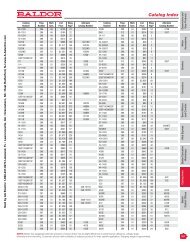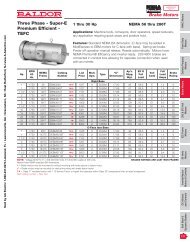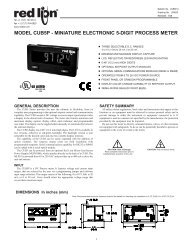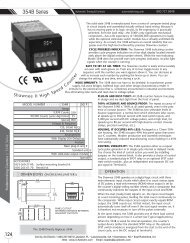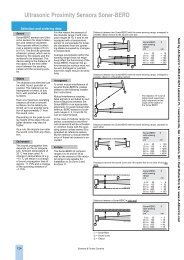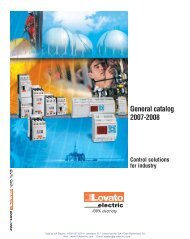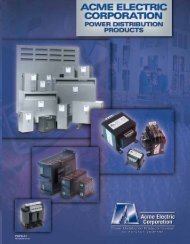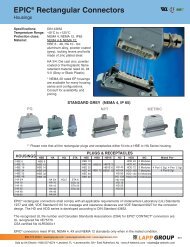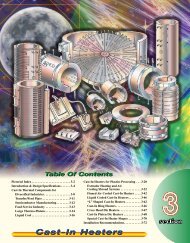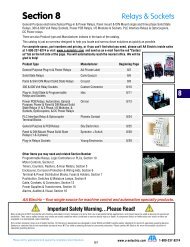Create successful ePaper yourself
Turn your PDF publications into a flip-book with our unique Google optimized e-Paper software.
<strong>API</strong> 1200 G<br />
<strong>API</strong> 1220 G<br />
Frequently Asked Questions<br />
Application Information<br />
Temperature<br />
DEFINITION<br />
Deadband is the range through which an input can be varied without<br />
initiating an observable response. Deadband is usually expressed in<br />
percent of span.<br />
What is Deadband?<br />
EXAMPLE<br />
A 20% total deadband is applied to the setpoint of a monitored parameter.<br />
The relay will trip and reset to its untripped state as indicated in the<br />
following graph.<br />
20% TOTAL DEADBAND<br />
Can the <strong>API</strong> 1200 G provide a setpoint of 7°C and a reset point of<br />
6°C with an overall temperature span of 0-10°C?<br />
No. The minimum span we can operate in is a temperature difference<br />
equivalent to 5 mV of output change from the thermocouple.<br />
For example, a type J will produce 0.000 millivolts thermoelectric voltage<br />
at 0°C and 5.268 millivolts at 100°C. Therefore, the minimum temperature<br />
span is about 100°C. For the set point at 7°C and reset point<br />
at 6°C, the thermocouple itself has enough of a variance (usually 5%)<br />
to it that its output will not be exactly the same. Therefore, we can not<br />
guarantee the repeatability of the system to trip at 7°C each time.<br />
What is cold junction compensation and why is it necessary?<br />
Cold junction compensation is required for accurate temperature measurement<br />
when using a thermocouple. A thermocouple junction, created<br />
whenever two dissimilar metals are connected together (such as Iron<br />
and Copper-Nickel), produces a potential difference that varies with<br />
temperature. Thermocouples generate a millivolt signal that increases<br />
in proportion to the difference in temperature between the hot and the<br />
cold junctions.<br />
Thermocouple tables are based on a standard 0°C cold junction temperature.<br />
Instruments designed to read thermocouples have a temperature<br />
sensor at the instrument connection point designed to electronically<br />
correct the reading to the 0°C standard. A millivolt meter can’t be<br />
used to accurately read a thermocouple directly since it has no 0°C<br />
compensation and any additional connections with dissimilar metals<br />
creates new thermocouple junctions adding to the error.<br />
90<br />
<strong>API</strong> maintains a constant effort to upgrade and improve its products. Specifications<br />
are subject to change without notice. Consult factory for your specific requirements.<br />
.<br />
Sold by <strong>AA</strong> <strong>Electric</strong> 1-800-237-8274 Lakeland, FL • Lawrenceville, GA • Greensboro, NC • East Rutherford, NJ www.A-Aelectric.com



